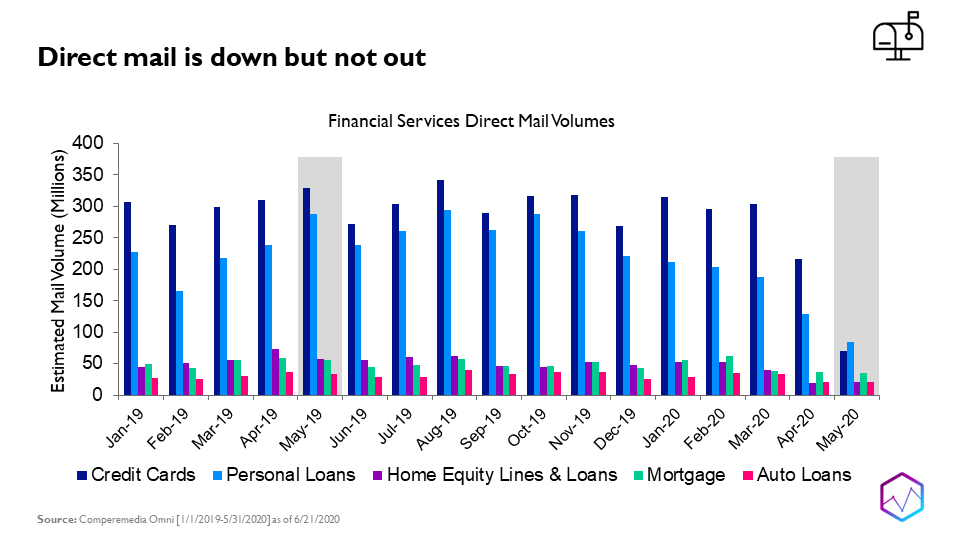The coronavirus pandemic has altered the U.S. economic landscape triggering a significant slowdown in marketing activity across industries. As such, marketers are re-evaluating their strategies to better align with the changing needs of customers. If you focus on financial marketing, you may be asking, "what now?"
In our recent webinar, “Marketing Reboot: Smart Marketing in a Time of Covid,” Lily Harder from Comperemedia, a Mintel company and Steve Eulie from The Kessler Group discussed four key insights to help marketers better adapt to the "next normal" in financial marketing.
1. Focus on New Customer Needs
Quick-thinking marketers made significant pivots early on when the Coronavirus shelter-in-place orders went into effect state-by-state. They developed innovative value propositions, messaging and products in three key areas:
- Fees
- Rewards
- Giving back
Some credit card issuers waived fees for installment payments. Other brands added at-home activities to their rewards programs, such as streaming services and food delivery, while some tapped into consumers’ desire for self-care by offering complimentary memberships for meditation and fitness apps. In terms of giving back, one company teamed up with a major hotel chain to donate one million hotel nights for front-line workers.
2. Rework Direct Mail Strategy
“As soon as the pandemic hit, we saw a shift in marketers hitting pause and scaling back,” said Harder. According to Comperemedia, direct mail activity took the biggest hit, decreasing nearly 70% for all financial services in May 2020 compared to last year. Despite the sharp decline, Harder predicts that direct mail will rebound later this year when marketers retool their messaging.

Additionally, financial services total acquisition volume in May decreased 80% for credit cards, 70% for personal loans and 35% for mortgages, as compared to May 2019. Credit card and loan offers, specifically, decreased 40% from April to May 2020. In sharp contrast, retail banking was up more than 15% month-to-month, Comperemedia cited.
3. Look at Financial Durability
Consumers have been impacted in different ways during the pandemic. While some have increased savings and lowered debt, others have lost their jobs or experienced salary reductions. Therefore, marketers cannot rely solely on credit scores; it's time to lean into segmentation. Financial durability has become a more reliable way to segment the economic health of households within the same credit bands. It considers a consumer’s assets, income from dividends and interest, retirement income, and the relationships between income, debt and spending.
How Durability Reveals Differences
The graphic below illustrates how Equifax can segment prime households into cohorts with varying levels of economic capacity to reveal a richer picture. One-third of these households, or 36 million, have low to very low durability, according to Equifax data in June 2020. Therefore, they should be marketed to differently than their higher durability counterparts.

4. Understand This Recession is Different
This recession differs from the Great Recession of 2008. First, experts believe it will be contained by region and industry. Secondly, banks are still well capitalized, have strong balance sheets, and have adequate reserves—thanks to financial regulations and stricter lender policies, said Eulie. During the Great Recession, financial institutions pulled back on underwriting criteria, shed bad debt and cut credit lines. As a result, creditors are becoming customer-centric rather than shutting down lines or increasing pricing. “The approach to managing credit exposure has been much less aggressive than it was in 2008,” Eulie said. Most employment risk is in industries like leisure and hospitality, consumer services, and wholesale and retail trade. Employment in financial and professional activities has had minimal impact.
How to Market in the Next Normal
Equifax found that median credit scores, revolving credit utilization, monthly disposable income and debt-to-income ratios are all stronger today than during the Great Recession. Also, household deposits are four times as high, according to Equifax data from June 2008 to December 2019.
As such, forecasters expect economic output to begin growing again in the third quarter. Marketers aren’t far behind; many say they’re planning for a third-quarter reentry—not to previous levels, but forging the path. Marketers have an opportunity to succeed again, with the short-term future looking better. Consumers still need help growing their assets with financial services, so marketers should get creative with offers and messaging. Harder recommends that brands keep the following in mind as they navigate the Next Norm:
- Timely innovation – anticipate what your customers will need next in this crisis
- Community outreach and local focus – even though this is a global pandemic, the impact varies greatly by location
- Flexibility – be agile enough to adjust products, offers and communications to new consumer needs
Click here to learn more about powering your marketing with the right data.
Recommended for you






